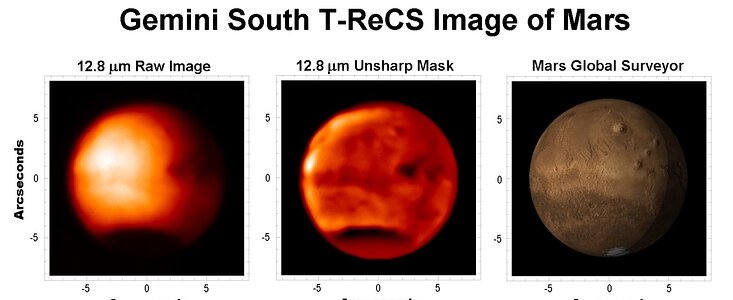Gemini South Mid-Infrared Imager T-ReCS Glimpses Dry Ice Frost on Mars
17 Junio 2003
On the second night of its first commissioning run on the Gemini South Telescope, the facility mid-infrared imager/spectrograph T-ReCS was used to obtain an image of Mars using a spectral filter centered at a wavelength of 12.8 microns. The image was made at 7h27m UTC on 2003 June 4.
Bright areas are relatively warm, and dark areas may be cooler. In the "raw" image on the left, the bright region corresponds to the sub-solar point; there is a brightness gradient roughly symmetrical about the sub-solar point, actually skewed a bit towards mid-afternoon due to thermal inertia.
The middle image shows a specially processed (unsharp-mask) version of the T-ReCS data that accentuates finer details. The right image is a composite of visible data from the Mars Global Surveyor (National Geographic Society, MOLA Science Team, MSSS, JPL, NASA) taken from the Mars Now webpage and shows Mars at approximately the same orientation during the time of the T-ReCS observations. Comparison of the infrared and visible images shows that many details, such as the southern polar cap and Olympus Mons (upper center large volcano), can also be seen in the T-ReCS processed image. Sun-facing slopes are warmer. The cold patches in the equatorial region, right-hand side must be due to condensate clouds or hazes.
Dr. Alfred McEwen (Lunar and Planetary Laboratory) suggests that, "the cool region over the south pole is due to CO2 frost, buffered at the CO2 frost temperature near 140K. An east-west trending stripe or arc of slightly cooler surface (equatorial, left-to-middle) corresponds to the brighter (higher albedo) stripe seen in the visible image (right image). A combination of high albedo and perhaps also higher thermal inertia keep this region a bit cooler in the day time. Other spatial variations are due to some combination of albedo, thermal inertia, atmospheric condensates or atmospheric dust."
These observations were made by a team from the University of Florida (UF) and Gemini Observatory (GO): Tom Hayward (GO), Charles Telesco (UF), Marie-Claire Hainaut-Rouelle (GO), Jim De Buizer (GO), James Radomski (UF), Naibi Marinas (UF) and Chris Packham (UF). We thank Alfred McEwen of the University of Arizona (Lunar and Planetary Laboratory) and Pete McGinnis-Marc of the Hawaii Institute of Geophysics and Planetology for helping with the interpretation of the images.


